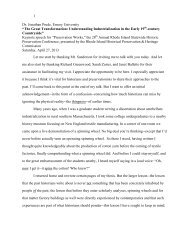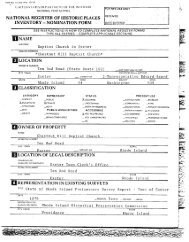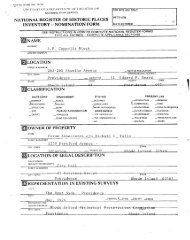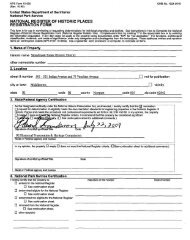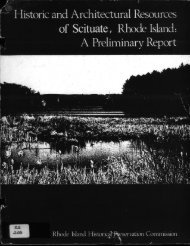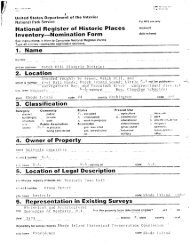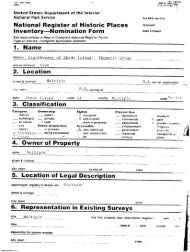National Park Service - Rhode Island Historical Preservation ...
National Park Service - Rhode Island Historical Preservation ...
National Park Service - Rhode Island Historical Preservation ...
You also want an ePaper? Increase the reach of your titles
YUMPU automatically turns print PDFs into web optimized ePapers that Google loves.
NPS Form 10400. 0MB IC 1024-0018<br />
Exp. 10-31-84<br />
United States Department of the Interior<br />
<strong>National</strong> <strong>Park</strong> <strong>Service</strong><br />
<strong>National</strong> Register of Historic Places<br />
Inventory-Nomination Form<br />
Continuation sheet 1 Item number 7<br />
Page 2<br />
shore of Saugatucket Pond #15 and #17 but excludes the sites of<br />
two demolished Hazard houses, including property along Kingstown<br />
Road occupied by residential subdivisions developed after 1948.<br />
The boundary includes Kingstown Road dwellings south of the<br />
village center as far as School Street, where the north end of<br />
Wakefield-oriented development begins. On the east it<br />
encompasses the village-related section of Broad Rock Road and<br />
the most important surviving Hazard family house, the Acorns<br />
#71. The border skirts two groups of late twentieth-century<br />
houses off the eastern end of Church Street on Rose Circle and<br />
Steven Circle. School Street constitutes the district’s south<br />
line for the reason noted above. On the west, the boundary<br />
follows the Saugatucket River in order to include Peace Daleoriented<br />
buildings on Columbia Street, then follows Church Street<br />
westward as far as the former Peace Dale Congregational Church<br />
parsonage #88, turning north again and following the back lot<br />
lines ofhouses lining Railroad Street, omitting undeveloped<br />
property to the west. At Railroad Street and Kingstown Road the<br />
boundary includes the historic Railroad Street Bridge#78, then<br />
jogs east and north again, omitting the vacant Narragansett Pier<br />
Railroad right-of-way and several non-historic commercial.<br />
buildings, continuing to the district’s northwest corner at the<br />
Peace Dale School #1.<br />
Topographically, Peace Dale presents a varied scene, with<br />
lowest elevations in the stream bed valleys and highest<br />
elevations along Railroad Street, Kersey Road, and Church Street<br />
at Brown Street. Most of the district is well wooded. However,<br />
the mill yard#37 is largely devoid of trees, as is the<br />
industrial property and former railroad land to the south and<br />
west #82, 90, 91. Other large open spaces include the<br />
landscaped Green #41, the grounds of the Peace Dale School 1,<br />
and the complex of school properties at the southwest corners of<br />
the district #110, 113, and 115.<br />
Village streets possess distinct visual and historic<br />
characteristics. The main thoroughfare, Kingstown Road, winds<br />
through Peace Dale from northwest to southeast. This is an<br />
eighteenth-century highway, save for the tortured course it<br />
follows around the mill complex. Until 1870 at least, Kingstown<br />
Road ran straight through the mill site; when the factory complex<br />
was enlarged in the ‘70s, the road was rerouted to accommodate<br />
industrial expansion. Bordering the mills #37 on the south,<br />
this section of Kingstown Road passes on the north a small group<br />
of commercial buildings #19, #20, #23; the remnant of a small,<br />
contiguous early nineteenth-century factory complex #22, and







